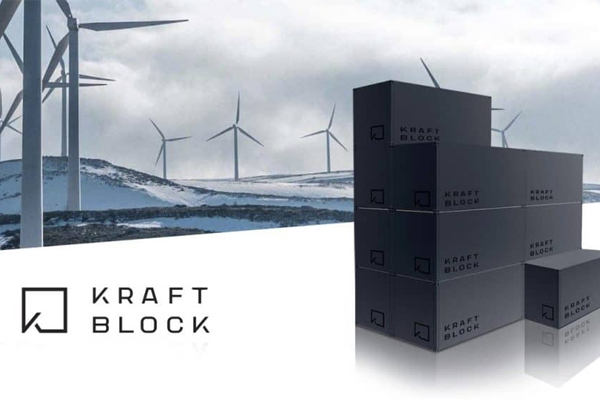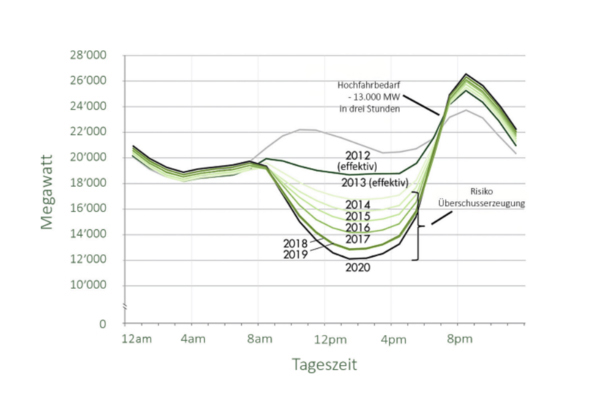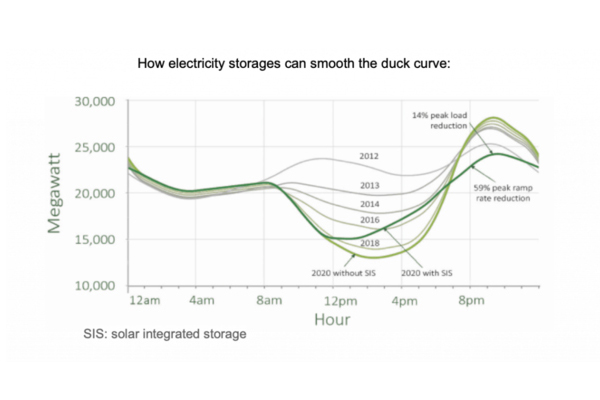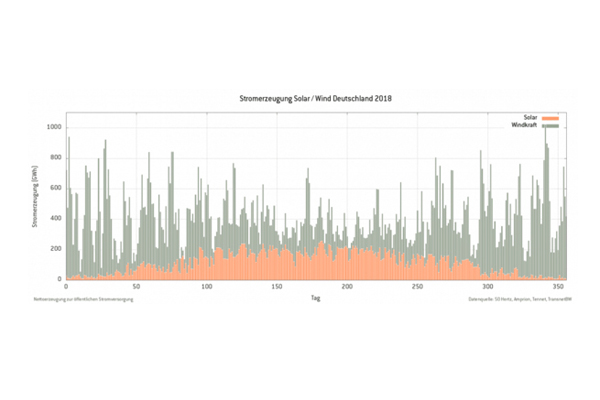Electricity storage can help smooth the "Californian Duck Curve," as shown in Figure 2. They do this by storing electricity during midday hours when solar generation is high and demand is low, and shifting it to evening hours when demand is high and solar generation is very low or non-existent. This smooths the curve and reduces the sudden spike in demand in non-renewable generation during the late afternoon hours.
Data source: Fraunhofer Institute for Solar Energy Systems et al. (2018).
Fraunhofer Institute data on the German electricity market shows that electricity generation from wind and solar sources not only fluctuates on a daily basis, but is also highly variable across weeks and seasons.
From 2008 to 2018, the share of wind and solar power grew from 8.3% to 28.8%. This is a 3.5-fold increase in 10 years.
The integration of these volatile renewables is becoming increasingly important and gaining urgency with a growing share of wind and solar energy in Germany.
In 2017 alone, Germany exported electricity abroad that would have been enough to power 15.4 million households for a year.
A common practice for days with (too) high production is currently so-called curtailment, in which plants are temporarily shut down or their production is throttled, for example, to prevent overloading the power grid.
Another option, also often used, is to export electricity, but this puts a strain on the power grids of neighboring countries and affects their electricity prices. Neither option is particularly helpful in achieving climate goals in a sustainable way.
Electricity storage can eliminate the need for curtailment as well as electricity exports, as the excess electricity could so easily be stored for later use.
In Germany alone, 5.5 TWh of electricity from renewable sources was curtailed in 2017 and approximately 77 TWh was exported. To give an example and a feel for the numbers: A 4-person household in a single-family home consumes about 4 to 5 MWh per year. This means that the exported electricity could have supplied 15.4 million households in Germany with (free) electricity for one year. Instead, we exported the electricity at mostly negative prices. In other words, we paid others to buy our electricity, while at the same time households have to pay ever higher electricity prices.
In addition, peak load power plants are added on days when renewable generation is low. These are power plants that are only in use a few days a year and typically have very high marginal costs that are passed on in the form of higher electricity prices. On top of that, they usually run on finite resources. In Germany, the 82 GW peak load is predominantly met by gas, coal, and nuclear power plants, and is also often used as an argument against a rapid coal phase-out. Electricity storage can clear the way for coal phase-out and energy transition by offering a more sustainable solution than these peak power plants and replacing them completely in the long term.
Energy storage relieves the strain on our grid and promotes grid stability
Yet electricity storage is also necessary and extremely useful from the perspective of grid operators.
By reducing system load at peak times, they can extend the life of the grid without wasting electricity.
In addition, they help ensure consistently high power quality: a mismatch between supply and demand can have a negative impact on power quality. This can cause instability in the grid and also potentially damage terminal equipment. An example that is probably familiar to most Germans is clocks that go wrong. These clocks use the 50 Hz frequency to measure time. Due to strong fluctuations in the network, the voltage can deviate, which can cause the clocks to malfunction.
However, voltage fluctuations can be easily fixed if the power supply can respond to them. Power storage can provide solutions for this that are much less expensive than the options currently in use.
In addition, electricity storage can be used to mitigate the impact of delayed investments in grid expansion. Germany has plans to expand its power grid by 7700 km. Of this, 1050 km have been built so far, less than 14%. The required investment is estimated at 50 billion euros. In 2018, 150 km were newly built, which is simply too little.
Combined with the increasing demand for electricity, this leads to bottlenecks in the supply of some areas. This is not only bad for the reliability and quality of the power supply, but also for the grid itself.
Electricity storage systems can therefore pave the way for renewable energy by smoothing out daily, weekly and seasonal fluctuations. They can eliminate the need for curtailment and replace peak load power plants. In addition, they can increase stability and reliability in the grid and extend its lifetime.
Power block, the first economically and ecologically sensible storage solution
For years, we at Freigeist Capital have been analyzing electricity storage and comparing available storage solutions. Until now, however, the available storage solutions were neither particularly durable nor ecologically sustainable due to their limited charging cycles. In addition, storage solutions such as batteries are extremely expensive and both the environment and the local population suffer from the mining of the required raw materials.
In Kraftblock, we have for the first time found a solution that is durable, ecologically sustainable, economically viable and scalable. That's why we invested.
Kraftblock is a modular, scalable energy storage system with capacities ranging from 4 MWh to 10,000 MWh. Its innovative technology makes it significantly cheaper than current lithium-ion batteries and cleaner, as it has no environmental impact: It is made of 85% recycled material and nearly 100% unlimited resources compared to critically available resources, such as cobalt. In addition, the storage material is 100% recyclable. It also has a virtually infinite lifespan and contains no toxic substances. Its very low storage cost of 1 - 4 cents/ KWh makes it not only ecological and sustainable, but also very economical.
The special feature of Kraftblock is the storage granules, which can store extremely high temperatures up to 1300 degrees in a very small space. The storage density is 3-10 times higher than comparable thermal storage systems, and the high storage temperature enables exceptionally efficient regeneration of electricity. All of these advantages make Kraftblock an extremely affordable and sustainable solution that can meet the energy storage needs to enable a successful energy transition.
A transition to renewable energy is inevitable if we are to limit the damage that ever-growing electricity consumption is doing to our environment and climate. Otherwise, we will feel the effects of rising greenhouse gas emissions in the form of climate change, which will affect us as a society, economy and individuals.
Solar and wind energy are "clean" but are subject to high fluctuations because solar and wind are not controllable. Therefore, we need energy storage to guarantee a reliable power supply with renewable energy sources. Kraftblock offers an ideal solution for this and is therefore an important step on our way towards a future with both a sustainable and reliable energy supply.
Back to overview




